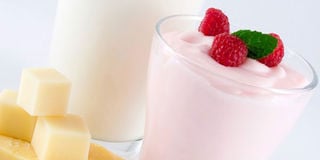The probiotics debate: Are these yoghurts worth all the marketing hype?

The probiotics debate: Are these yoghurts worth all the marketing hype?
What you need to know:
Now when you take a course of antibiotics, the medication kills the bad bacteria and all the good bacteria too. And this is where probiotics come in – they’re designed to replenish the good bacteria.
Before I dive into this question, let me first give you a bit of background on the large intestine and the micro-organisms that live there. The large intestine, or colon, contains huge numbers of bacteria and fungi (known as “bowel flora”), and our health is profoundly affected by the composition of this population. The “good” bacteria that live there not only help with producing vitamins and helping digestion, they also help to stimulate the immune system and control the numbers of potentially harmful micro-organisms.
Now when you take a course of antibiotics, the medication kills the bad bacteria and all the good bacteria too. And this is where probiotics come in – they’re designed to replenish the good bacteria.
There are many types of probiotics on the market, one of them being probiotic drinks (such as Yakult) – something I’m not particularly keen on.
You see, in order for these drinks to work, the “friendly” bacteria contained within them need to reach the large intestine. That means they need to survive the hydrochloric acid in your stomach, which has a pH of around 1.5. Whether they do is a matter of debate.
So, rather than the drinks, whose effectiveness is under question, it’s better to take a probiotic supplement. These are generally enteric-coated, which means they can withstand the assault of the stomach acid, and then get to where they’re needed.
What about the yoghurts that have been recently advertised ‘with probiotics’? Well, to say that yoghurt has probiotics is a bit like saying that a particular orange has vitamin C. In short, they all do! However, since we have become more aware of the benefits of probiotics, advertisers are now picking up on this and it just becomes another marketing ploy.
For me, we simply make our yoghurt at home, using a shop-bought yoghurt as a starter culture. It is super quick, fool-proof and cost-effective.
If you do decide to take a probiotic, it’s important to combine it with a prebiotic. A prebiotic is simply a substance that feeds this new friendly bacteria that you are trying to put into your gut so that they grow in number and crowd out the bad bacteria (noxious farts are a sign of bad bacteria gone wild!).
SIDE BAR
Six simple Steps to Making Homemade Yoghurt
- Boil the milk.
- Cool the milk to lukewarm (you should be able to put your finger in, but not too warm to kill the bacteria that you’re about to put in).
- Add your yoghurt starter. This is the good bacteria and can come from a reputable yoghurt manufacturer
- Stir the yogurt starter with the rest of the milk. Stir really, really well. I like to whisk it.
- Pour the milk into a clean glass or metal container and keep warm for 7-9 hours.
- Once set, keep in the fridge to cool.




